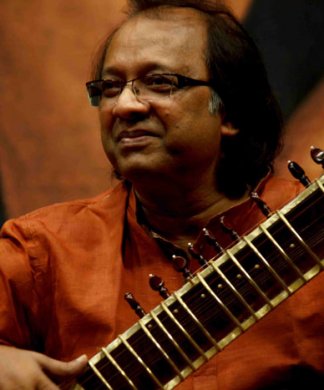By George Ruckert
CAMBRIDGE, MA–The distinguished Mumbai sitarist, Nayan Ghosh, wrapped up MITHAS’ twenty-fourth season on Saturday night with a recital in MIT’s Wong Auditorium that was nothing short of brilliant.
In truth, this entire concert season was especially stellar, in that the final three concerts featured several of India’s most accomplished artists, including Carnatic vocalists T.M. Krishna and Suguna Varadachari, as well as Bharatnayam dancer Priyadarshini Govind, all of whom presented spellbinding programs in the richest classical traditions.

In this final program of the season, Nayanji was accompanied by his gifted son Ishaan on tabla; and father and son were in top form in presenting traditional ragas
in both chaste and exciting recitals. The concert began with alap and jor in Shuddh Kalyan, and for those who know the rag in its vocal format, there was a surprise in hearing it in a different version (one originally pioneered by Allauddin Khan and his son Ali Akbar Khan). The characteristic slow slides from sa to dha and pa to ga were there, but the novel way of using ni created a pleasing diversion that vocalists do not usually use. A slow gat in tintal brought in the accompaniment of the 16-year-old Ishaan, who played with startling maturity and elan, drawing many ovations from the rapt audience. A sparkling fast gat drew the first half to a conclusion.
The second half featured the rag Pahari Jhinjoti, which has an embedded sweetness that Nayanji evoked from his instrument, both in his touch of the notes, the complex pulls (meends) on the sitar, and the choice of compositions. The mood was in total contrast with the first half, which indeed did not lack sweetness; but in that Shuddh Kalyan demanded a devotional chasteness to the playing, Pahari Jhinjoti differed in its bhakti, laden as it was with the moods of sringar and karuna (love and compassion). In a medium gat in sitarkhani tal, Nayanji suddenly paused for a second and said, “This composition just came to me, and I composed it on the spot.” Brilliant tans followed, astonishing in their dexterity and invention.
The concert closed with a short dhun (folk-like melody), which used borrowed tones that sometimes invoked the blues, and at others briefly suggested other rags. It showed his enchantment with the sound of Vilayat Khansahib’s famous presentations of lighter music, in which the tonal ambience of the satisfying sweetness of the sitar overrode the intellectual aspects of tan and tihai—a wholly satisfying conclusion to a great evening of music.
In his modesty, he would not approve of my saying so, but Nayan Ghosh has solidly joined the great stalwarts of the instrumental era that has just passed: that of Ravi Shankar, Nikhil Banerjee, Vilayat Khan, and Ali Akbar Khan. His musical heritage is impeccable, since his father was Nikhil Ghosh, who established a respected institute for music in Mumbai, and his family tree includes the famous flutist Panallal Ghosh and the late Jnan Prakash Ghosh of Kolkata. All this inherited tradition and learning blossoms in fiery colors his music. When he next comes to town, make special plans to be there.















